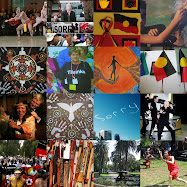
There's a flock of sulphur-crested white cockatoos living in my local park. One day recently I felt like I was starring in a scene from The Birds.
To see other skies from around the world, click on these words.







 I just snapped this off as we headed towards the Harbour Bridge after visiting my in-laws. You can see the Opera House sails to the left. Just proves that not ALL shots of the Harbour Bridge and Opera House are scenic and picturesque, and for all they are internationally known iconic images of Sydney, they're also just part of the fabric of the everyday life of a sprawling city of 4.4 million people.
I just snapped this off as we headed towards the Harbour Bridge after visiting my in-laws. You can see the Opera House sails to the left. Just proves that not ALL shots of the Harbour Bridge and Opera House are scenic and picturesque, and for all they are internationally known iconic images of Sydney, they're also just part of the fabric of the everyday life of a sprawling city of 4.4 million people.


 Gangway at the Overseas Passenger terminal at Circular Quay. The only boats that depart from here these days are luxury cruise ships. Most often they are the ones which cannot fit under the bridge (like The World Condominium ship).
Gangway at the Overseas Passenger terminal at Circular Quay. The only boats that depart from here these days are luxury cruise ships. Most often they are the ones which cannot fit under the bridge (like The World Condominium ship).


 A pic from my stock of Sculpture By The Sea snaps from last year. (To view all my 2008 Sculpture By The Sea posts CLICK HERE.) I hadn't previously published it, even though it was a favourite - I was saving it for a Skywatch Friday, and then it kind of got lost in the picture vault!
A pic from my stock of Sculpture By The Sea snaps from last year. (To view all my 2008 Sculpture By The Sea posts CLICK HERE.) I hadn't previously published it, even though it was a favourite - I was saving it for a Skywatch Friday, and then it kind of got lost in the picture vault!


 A transport spaghetti at the Convention Centre at Darling Harbour. The elevated freeway, elevated monorail and ground level light rail. In the background is the old Goldsborough Mort woolstore building, built in 1883, now redeveloped as apartments.
A transport spaghetti at the Convention Centre at Darling Harbour. The elevated freeway, elevated monorail and ground level light rail. In the background is the old Goldsborough Mort woolstore building, built in 1883, now redeveloped as apartments. Pyrmont Bridge, a swing opening bridge, spans Cockle Bay in Darling Harbour. It used to be a main vehicle bridge in to Sydney, but once replaced by new freeways in the 1980s, it became a pedestrian bridge.
Pyrmont Bridge, a swing opening bridge, spans Cockle Bay in Darling Harbour. It used to be a main vehicle bridge in to Sydney, but once replaced by new freeways in the 1980s, it became a pedestrian bridge.





 Top: Rolf Harris - entertainer
Top: Rolf Harris - entertainer

 Sydney City Council's banner at left is the work of artist Bronwyn Bancroft, a Djanbun (pronounced Jaan’bun) woman from the Bundjalung (Bun-jaa-lung) Nation of Northern NSW. She was born in a small country town in regional NSW, but lived most of her adult life in Sydney. She is a well known Aboriginal artist who has exhibited her work both nationally & internationally. Bronwyn Bancroft stated, “I am pleased that the design will be used throughout the city, as I would love to see more permanent visual Memorials to Aboriginal People…Past, Present and Future.”
Sydney City Council's banner at left is the work of artist Bronwyn Bancroft, a Djanbun (pronounced Jaan’bun) woman from the Bundjalung (Bun-jaa-lung) Nation of Northern NSW. She was born in a small country town in regional NSW, but lived most of her adult life in Sydney. She is a well known Aboriginal artist who has exhibited her work both nationally & internationally. Bronwyn Bancroft stated, “I am pleased that the design will be used throughout the city, as I would love to see more permanent visual Memorials to Aboriginal People…Past, Present and Future.”
 Campbell's Cove at west Circular Quay is an area of jazzed-up waterfront. The former bond stores are now upmarket restaurants. The glass and steel building at left in the photo at left is the Overseas Passenger Terminal where the large cruise ships tie up. The bar I showed two days ago ("Cruise Bar") is in this building looking out over the water.
Campbell's Cove at west Circular Quay is an area of jazzed-up waterfront. The former bond stores are now upmarket restaurants. The glass and steel building at left in the photo at left is the Overseas Passenger Terminal where the large cruise ships tie up. The bar I showed two days ago ("Cruise Bar") is in this building looking out over the water.
 This is the coolest hotspot, or hottest coolplace in Sydney at the moment: the Apple store. I'm not advertising, honestly. I went in yesterday to get a couple of things, and fell truly, madly, deeply in lust. Waaaaaaaaaaaaaaaaaah! I wanna Mac. I wanna MacBook.
This is the coolest hotspot, or hottest coolplace in Sydney at the moment: the Apple store. I'm not advertising, honestly. I went in yesterday to get a couple of things, and fell truly, madly, deeply in lust. Waaaaaaaaaaaaaaaaaah! I wanna Mac. I wanna MacBook.

 Back to our walk around the Circular Quay / Dawes Point area under the southern end of the Harbour Bridge.
Back to our walk around the Circular Quay / Dawes Point area under the southern end of the Harbour Bridge.
